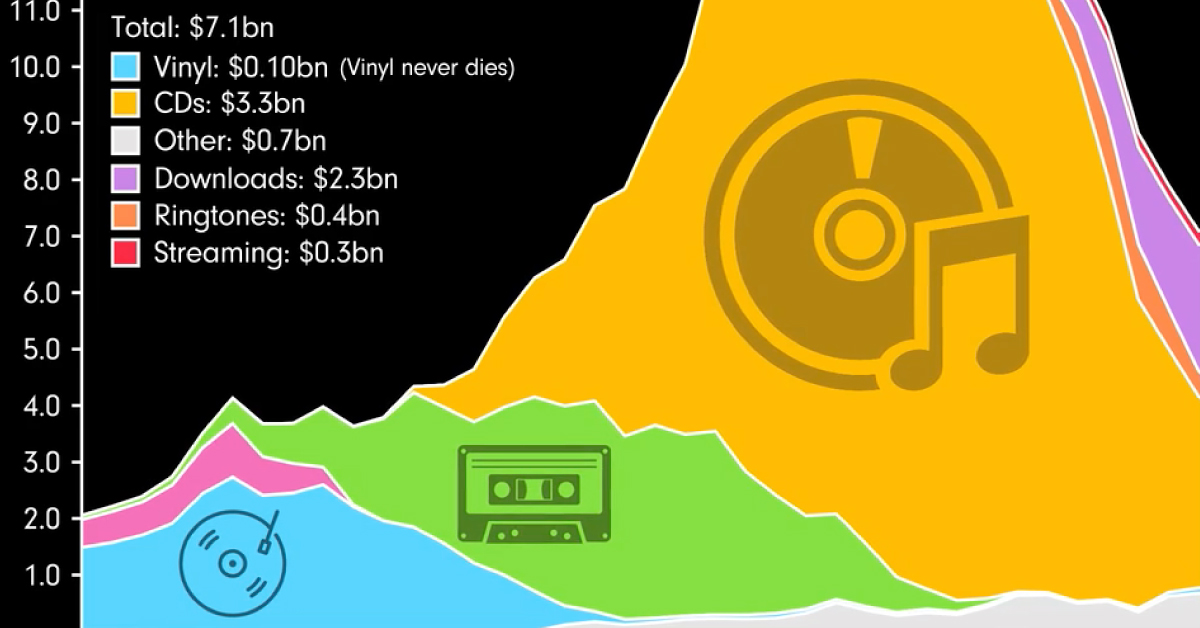Culture
Animated Chart: The Rise and Fall of Music Sales, by Format (1973-2021)
The Rise and Fall of Music Sales, by Format (1973-2021)
We live in a world of music. Whether when driving to work or jamming out at home, people around the world like to have their favorite tunes playing in the background.
But while our love for music has been constant, the way we consume media has evolved drastically. The past 50 years have seen many different music formats used to access these tunes, mirroring society’s shift from analog to digital.
This video, created by James Eagle using data from the Recording Industry Association of America (RIAA), highlights sales of different music formats in the U.S. over the last 50 years.
Vinyl
Up until the late 1980s, vinyl dominated the music format industry, earning billions of dollars in sales annually. Records of Bruce Springsteen’s Born to Run or Pink Floyd’s Dark Side of the Moon were some of the top selling albums available.
Vinyl is said to provide its listeners with analog sounds that reverberate and the warm notes of almost-live music. For vinyl users and enthusiasts to this day, the music produced by these sleek yet massive records is unparalleled.
8-Track
If you’re a millennial (or younger), you may have never heard of the 8-track. But this music format played an integral part in the history of music.
When the booming automotive vehicle industry found it challenging to translate the music experience to cars using vinyl, it looked to the “Stereo 8” eight-track cartridge, better known as the 8-track. This cartridge used an analog magnetic tape and provided 90 minutes of continuous music play time.
8-track carved a niche for itself much before the advent of cassettes and CDs. And through the proliferation of vehicles, 8-track sales climbed to reach a peak revenue of $900 million in 1978.
Cassettes
The era of cassettes pushed 8-tracks into the history of music in the early 1980s. These pocket-sized tapes were more convenient to use than 8Tracks and quickly spread worldwide.
By 1989, the cassette format reached its peak revenues of $3.7 billion.
CDs
First released in 1982, the Compact Disc or CD came into the music market as the successor to the vinyl record.
Developed by Philips and Sony, sales of the sleek and portable CD grew quickly as home and car stereos alike added CD functionality. The format brought in $13.3 billion in revenue in both 1999 and 2000. To date, no other music format has reached the same milestone since.
Digital Music Formats
When it comes to preferred music formats over time, convenience (and cost) seem to have been the biggest catalysts of change.
From the start of the early 2000s, CDs had started to be replaced by other forms of digital storage and distribution. The massive shift to internet consumption and the introduction of digital music, available through downloads, pushed audio CD sales down rapidly.
The launch of streaming platforms like Spotify in 2006 exacerbated this decline, with CD sales dropping by around $4 billion in five years.
Digital sales continued to evolve. Ringtone sales alone brought in $1.1 billion in 2007, and in 2012, the revenues from downloads shot up to a peak of $2.9 billion. But music streaming platforms kept climbing through 2021, and will likely continue to be the future face of music consumption.
| Rank | Music formats | Revenue in 2021 |
|---|---|---|
| 1 | Streaming | $11.5 billion |
| 2 | Vinyl | $1.0 billion |
| 3 | CD | $0.6 billion |
| 4 | Downloads | $0.5 billion |
| Other | $1.4 billion | |
| Total | $15.1 billion |
Music streaming and subscription services pushed the accessibility of music to new highs, especially with free ad-supported platforms.
In 2021, streaming secured the music industry a whopping $11.5 billion in sales, good for 76% of the total. If it keeps growing in popularity and accessibility, the format could potentially challenge the peak popularity of CDs in the late 90s.
The Vintage Comeback?
There’s no doubt that digital music formats are getting increasingly popular with every passing year. However, one of our vintage and beloved music formats—the vinyl record—seems to be making a comeback.
According to the RIAA database, the revenue earned by LP/EP sales has shot up to $1.0 billion in 2021, its highest total since the mid-1980s.

This article was published as a part of Visual Capitalist's Creator Program, which features data-driven visuals from some of our favorite Creators around the world.
Technology
How Tech Logos Have Evolved Over Time
From complete overhauls to more subtle tweaks, these tech logos have had quite a journey. Featuring: Google, Apple, and more.

How Tech Logos Have Evolved Over Time
This was originally posted on our Voronoi app. Download the app for free on iOS or Android and discover incredible data-driven charts from a variety of trusted sources.
One would be hard-pressed to find a company that has never changed its logo. Granted, some brands—like Rolex, IBM, and Coca-Cola—tend to just have more minimalistic updates. But other companies undergo an entire identity change, thus necessitating a full overhaul.
In this graphic, we visualized the evolution of prominent tech companies’ logos over time. All of these brands ranked highly in a Q1 2024 YouGov study of America’s most famous tech brands. The logo changes are sourced from 1000logos.net.
How Many Times Has Google Changed Its Logo?
Google and Facebook share a 98% fame rating according to YouGov. But while Facebook’s rise was captured in The Social Network (2010), Google’s history tends to be a little less lionized in popular culture.
For example, Google was initially called “Backrub” because it analyzed “back links” to understand how important a website was. Since its founding, Google has undergone eight logo changes, finally settling on its current one in 2015.
| Company | Number of Logo Changes |
|---|---|
| 8 | |
| HP | 8 |
| Amazon | 6 |
| Microsoft | 6 |
| Samsung | 6 |
| Apple | 5* |
Note: *Includes color changes. Source: 1000Logos.net
Another fun origin story is Microsoft, which started off as Traf-O-Data, a traffic counter reading company that generated reports for traffic engineers. By 1975, the company was renamed. But it wasn’t until 2012 that Microsoft put the iconic Windows logo—still the most popular desktop operating system—alongside its name.
And then there’s Samsung, which started as a grocery trading store in 1938. Its pivot to electronics started in the 1970s with black and white television sets. For 55 years, the company kept some form of stars from its first logo, until 1993, when the iconic encircled blue Samsung logo debuted.
Finally, Apple’s first logo in 1976 featured Isaac Newton reading under a tree—moments before an apple fell on his head. Two years later, the iconic bitten apple logo would be designed at Steve Jobs’ behest, and it would take another two decades for it to go monochrome.
-

 Mining1 week ago
Mining1 week agoGold vs. S&P 500: Which Has Grown More Over Five Years?
-

 Markets2 weeks ago
Markets2 weeks agoRanked: The Most Valuable Housing Markets in America
-

 Money2 weeks ago
Money2 weeks agoWhich States Have the Highest Minimum Wage in America?
-

 AI2 weeks ago
AI2 weeks agoRanked: Semiconductor Companies by Industry Revenue Share
-

 Markets2 weeks ago
Markets2 weeks agoRanked: The World’s Top Flight Routes, by Revenue
-

 Countries2 weeks ago
Countries2 weeks agoPopulation Projections: The World’s 6 Largest Countries in 2075
-

 Markets2 weeks ago
Markets2 weeks agoThe Top 10 States by Real GDP Growth in 2023
-

 Demographics2 weeks ago
Demographics2 weeks agoThe Smallest Gender Wage Gaps in OECD Countries












